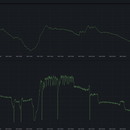Why would Mitsubishi heat pumps not run at 100% if the thermostat isn’t satisfied?
I have a Home Assistant server which allows integration of my energy monitoring system with high accuracy temp/humidity sensors. Despite consistently seeing outdoor temps running 104-108F (5-9 degrees) above design temperatures for the last several weeks I’ve noticed that the power draw on the units indicates they are not running 100% until the thermostat temp has been satisfied.
Because of the extreme heat I have had the thermostat set to 72F across the day to compensate for the temperature creep later in the day. But even when the sun goes down it might take 8-10 hours for the 3 degrees of temperature creep to be resolved.
It is almost like the unit is coasting to the target on an efficiency-maximizing timeline instead of comfort-maximizing.
Any thoughts on what might be going here?
FWIW – The watts displayed are based on 1-leg of the 220v power so the actual energy consumption is 2x what is displayed.
I also don’t really understand why the energy consumption rapidly bounces between 500-1200w (per 120v leg) some days and not others.
Full size graphs
https://i.imgur.com/UvN3tsl.png
GBA Detail Library
A collection of one thousand construction details organized by climate and house part











Replies
I sometimes think of minisplit thermostat set points as a "power" knob where instead of having a scale of 0-10, it's something like 54-82, (or 82-54 in the case of cooling).
With stable loads, I find they can get pretty much on point. With loads that fluctuate substantially, they can sometimes be a bit slow to respond.
I think the key thing you need to ascertain is whether this is "simply" a control problem, or if there is any problem with the unit's ability to run sustained maximum power (or if it backs off for any reason). I know my Fujitsu units have a "forced cooling" button on the indoor unit itself which will max the cooling capability regardless of room temp. Not sure if Mitsubishi units have similar. (I suspect they might as I think this button is mainly there to facilitate pumping down refrigerant to safely disconnect a unit.)
I would give this a shot, and if the unit happily cranks out lots of ice cold air for a significant period (perhaps 30 minutes or so), you can probably move back to diagnosing as a control problem.
Sometimes a temp sensor in a more representative area of the room is a way to get the unit to respond more accurately. You could also try fixing the fan speed on medium or high rather than auto and see how that works. Lastly, sometimes it just comes down to having to adjust it, either manually or with a programmed schedule that adjusts the set point relative to how hard you want it working at a given time.
Mini split or multi split?
Factory installed internal sensors and controls or third-party thermostat?
Dry mode or normal mode?
Any changes to the thermostats set point?
Walta
1x - MXZ-2C20NA2-U1 -> PEAD-A09AA7 & SEZ-KD09NA4
1x - PUZ-A24NHA7 -> PEAD-A24AA7
3x MHK2 Thermostats
Normal Mode
Thermostat setpoint has been specifically held at 72F
So, you have one mini split and one multi split.
My wild guess is that the units would run the way you expect if you disconnected Kumo stats and used the built in controls with the optional wired remote senor.
Walta
I like to say that mini splits have a little efficiency game they play[no no I won't turn off] and it is our job to figure out how to play a different game[no I don't want to freeze/sweat]
As Patrick mentioned, play with the fan.
Minisplits do no run to a setpoint and shut off, they kind of sneak up to a setpoint and try to avoid shutting off, but they do not have enough information [or they use the same weather my phone does] to make good enough decisions. At present we are smarter than the mini split
In my house this means turning the fan down at night and up again first thing if it will be hot, maybe auto if it is moderate.